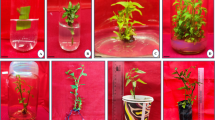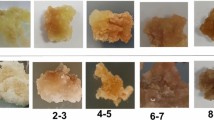Abstract
An effective protocol for in vitro microrhizome induction was developed for Acorus calamus. The explants, rhizome axillary buds, were cultured on dual phase Murashige and Skoog (MS) medium consisting of agar solidified phase overlaid by liquid fraction of the same medium. In this study, the effects of indole butyric acid (IBA) and — naphthalene acetic acid (NAA) containing 2–10% (w/v) sucrose were examined on microrhizome induction. Best response was observed on the medium supplemented with 2.0 mg L−1 IBA and 60% sucrose under 16/8 hours light/dark photoperiod which produced the maximum rhizome fresh weight (0.82 g) and size (length 4.8 cm; diameter 0.55 cm) in 6 weeks. The microrhizomes had 7–8 buds which were developed independent of season and each segment sprouted into roots and shoots when transplanted to soil. This protocol can be adopted for various applications, viz., large scale production of propagules of elite cytotype, in vitro conservation of the microrhizome, synthesis of secondary metabolites and for studying the biosynthetic pathways of the bioactive molecules present in the rhizomes of this important medicinal and aromatic plant.
Similar content being viewed by others
Literature Cited
Abel, G. 1987. Chromosome damage in human lymphocyte induced by -asarone. Planta Medica 53:251–253.
Ahlawat, A., K. Meenu, R. Gandhi, and A. Ashok. 2010. Genetic diversity in Acorus calamus L. as revealed by RAPD markers and its relationship with β-asarone content and ploidy level. Sci. Hortic. 124:294–297.
Anisuzzaman, M., S.A. Sharmin, S.C. Mondal, R. Sultana, M. Khalekuzzaman, I. Alam, and M.F. Alam. 2008. In vitro microrhizome induction in Curcuma zedoaria (Christm.) Roscoe — A conservation prioritized medicinal plant. J. Biol. Sci. 8:1216–1220.
Bhat, S.R., K.P.S. Chandel, and A. Kackar. 1994. In vitro induction of rhizomes in Zingiber officinale Roscoe. Ind. J. Exp. Biol. 32:340–344.
Chirangini, P., S.K. Sinha, and G.J. Sharma. 2005. In vitro propagation and microrhizome induction in Kaempferia galanga Linn and K. rotunda Linn. Ind. J. Biotech. 4:404–408.
Chopra, R.N., S.L. Nayer, and I.C. Chopra. 1992. Glossary of Indian medicinal plants. 3rd ed. Council of Scientific and Industrial Research, New Delhi, India.
Cousins, M., J. Adelberg, F. Chen, and J. Rieck. 2007. Antioxidant capacity of fresh and dried rhizomes from four clones of turmeric (Curcuma longa L.) grown in vitro. Ind. Crops Prod. 25:129–135.
Dušek, K., B. Galambosi, E.B. Hethelyi, K. Korany, and K. Karlová. 2007. Morphological and chemical variations of sweet flag (Acorus calamus L.) in the Czech and Finnish gene bank collection. Hort. Sci. (Prague) 34:17–25.
Gamborg, O.L., R.A. Miller, and K. Ojima. 1968. Nutrient requirements of suspension cultures of soybean root cells. Exp. Cell. Res. 50: 151–158.
Harikrishnan, K.L. and M. Hariharan. 1999. In vitro clonal propagation of sweet flag (Acorus calamus L.) — A medicinal plant, p. 220–222. In: P.D. Kavi Kishor (ed.). Plant tissue culture and biotechnology: Emerging trends. Universities Press, Hyderbad, India.
Hutchings, A., A.H. Scott, G. Lewis, and A.B. Cunningham. 1996. Zulu medicinal plants: An inventory. University of Natal Press, Piettermaritzburg, South Africa. p. 22–23.
Kim, Y.S. 2008. Evaluation of the water purification capacity in Iris pseudacorus and Acorus calamu. Kor. J. Hort. Sci. Technol. 26:172–176.
Lee, J.-H. and T.-H. Han. 2011. Micropropagation of the plantlets derived from seeds in the genus Acorus (A. calamus and A. gramineus). Hort. Environ. Biotechnol. 52:89–94.
McGaw, L.J., A.K. Jager, and J. Staden. 2002. Isolation of -asarone, an antibacterial and anti-helminthic compound from Acorus calamus in South Africa. South African J. Bot. 61:31–35.
Murashige, T. and F. Skoog. 1962. A revised medium for rapid growth and bioassay with tobacco tissue culture. Physiol. Planta. 15:473–497.
Nayak, S. 2000. In vitro multiplication and microrhizome induction in Curcuma aromatica Salisb. Plant Growth Regul. 32:41–47.
Patra, A. and A.K. Malik. 1981. Constituents of Acorus calamus: Structure of acoramone carbon-13 NMR spectra of cis- and trans asarone. J. Nat. Prod. 44:668–669.
Raghu, R.V. 1997. Micropropagation of turmeric (Curcuma longa L.) by in vitro microrhizomes, p 27–30. In: S. Edison, K.V. Ramana, B. Saskumar, B.K. Nirmal, and J.E. Santhosh (eds.). Biotechnology of spices, medicinal and aromatic crops. Indian Society for Spices, Calicut, India.
Rani, A.S., V.V. Subhadra, and V.D. Reddy. 2000. In vitro propagation of Acorus calamus Linn.— A medicinal plant. Ind. J. Expt. Biol. 38:730–732.
Ross, H.A. and H.V. Davies. 1992. Sucrose metabolism in tubers of potato (Solanum tuberosum L.). Plant Physiol. 98:287–293.
Sandhyarani, N., R. Kishor, and G.J. Sharma. 2011. Clonal propagation of triploid Acorus calamus Linn. using dual phase culture system. J. Crop Sci. Biotechnol. 14:85–95.
Seo, B.S. and C.M. Park. 2005. Removal effect of nitrogen and phosphorus of Acorus calamus var. angustatus on its growth stage and water-storage time. Kor. J. Environ. Ecol. 19:1–8.
Shirgurkar, M.V., C.K. John, and R.S. Nadgauda. 2001. Factors affecting in vitro microrhizome production in turmeric. Plant Cell Tiss. Org. Cult. 64:5–11.
Sunitibala, H., M. Damayanti, and G.J. Sharma. 2001. In vitro propagation and rhizome formation in Curcuma longa Linn. Cytobios. 105:71–82.
Thorpe, T.A. 1982. Carbohydrate utilization and metabolism, p. 325–368. In: J.M. Bonga and D.J. Durzan (eds.). Tissue culture in forestry. Martinus Nijhoff Publisher, Dordrecht.
Tyagi, R.K., S.R. Bhat, and K.P.S. Chandel. 1998. In vitro conservation strategies for spices crop germplasm Zingiber, Curcuma and Piper species, p. 77–82. In: N.M. Mathew and J.C. Kuruvila (eds.). Developments in plantation crop research. Rubber Research Institute of India, Kerala, India.
Venskutonis, P.R. and A. Dagliyte. 2003. Composition of essential oil of sweet flag (Acorus calamus L.) leaves at different growing phases. J. Essenential Oil Res. 15:313–318.
Vojtíšková, L., E. Murzarová, O. Votrubova, H. Čížková and H. Lipavská. 2006. The influence of nitrogen nutrition on the carbohydrate and nitrogen status of emergent macrophyte Acorus calamus L. Hydrobiologia. 563:73–85.
Wang, H.Z., Y.G. Cheng, and C.S. Fan. 1998. Review of studies on chemical constitutents and pharmacology of genus Acorus. Acta Bot. Yunn. 5:96–100.
Author information
Authors and Affiliations
Corresponding author
Rights and permissions
About this article
Cite this article
Devi, N.S., Kishor, R. & Sharma, G.J. Microrhizome induction in Acorus calamus Linn. — An important medicinal and aromatic plant. Hortic. Environ. Biotechnol. 53, 410–414 (2012). https://doi.org/10.1007/s13580-012-0096-1
Received:
Revised:
Accepted:
Published:
Issue Date:
DOI: https://doi.org/10.1007/s13580-012-0096-1




